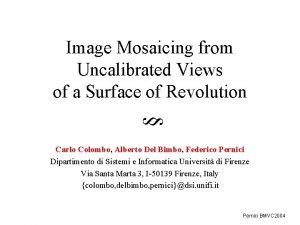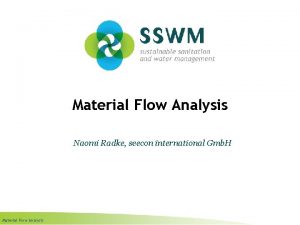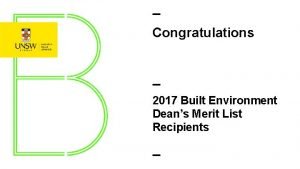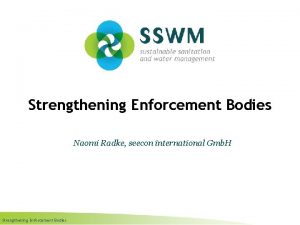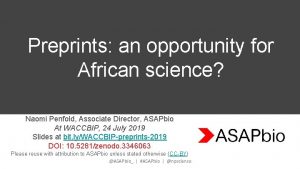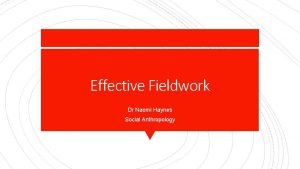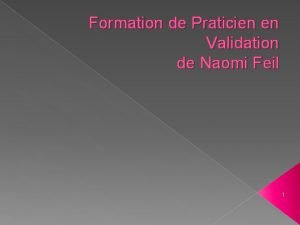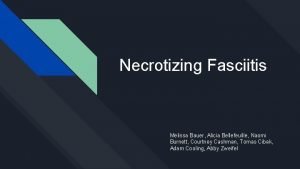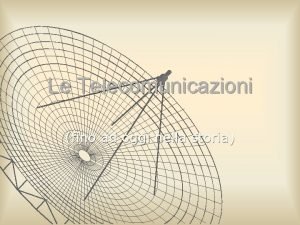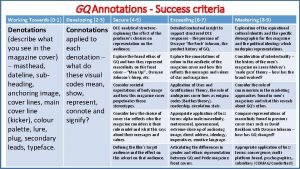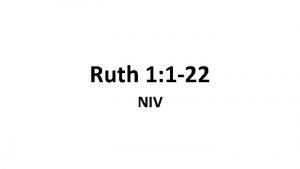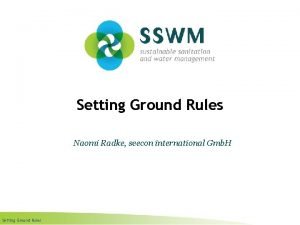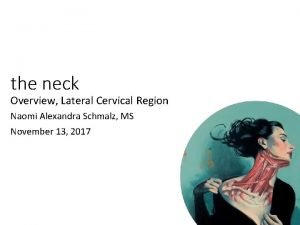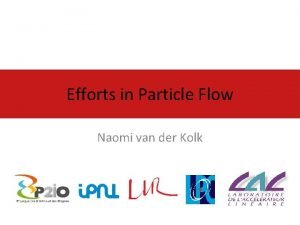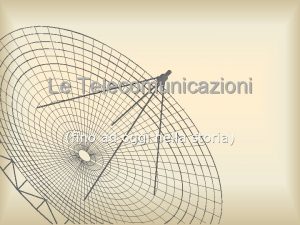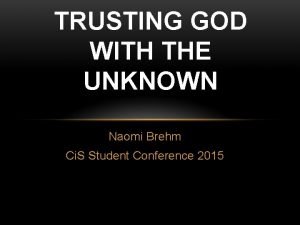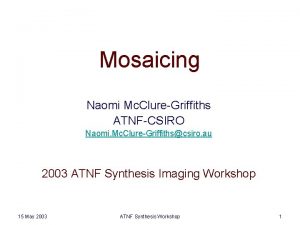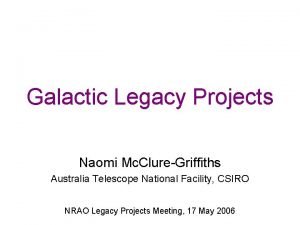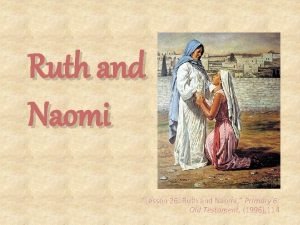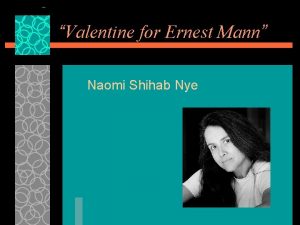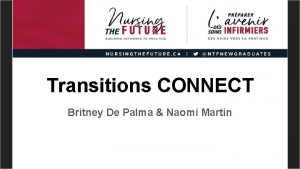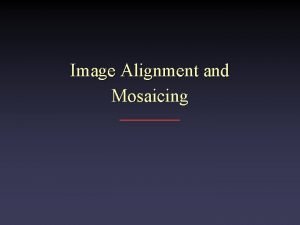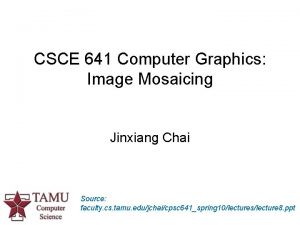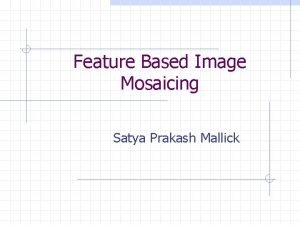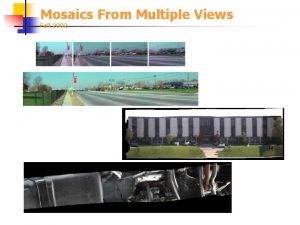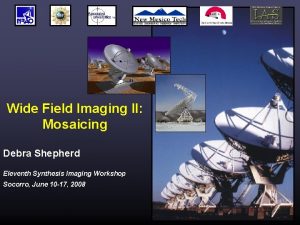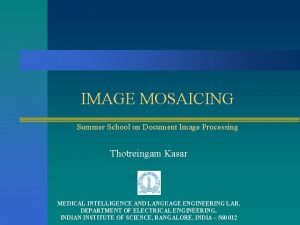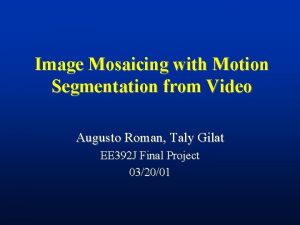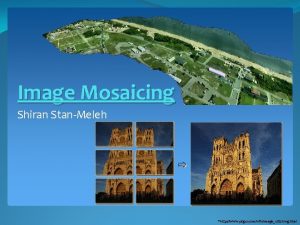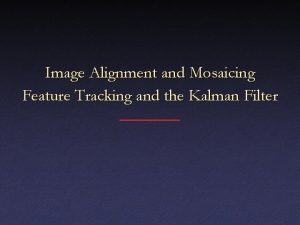Mosaicing Naomi Mc ClureGriffiths ATNFCSIRO Naomi Mc ClureGriffithscsiro

























- Slides: 25

Mosaicing Naomi Mc. Clure-Griffiths ATNF-CSIRO Naomi. Mc. Clure-Griffiths@csiro. au 2003 ATNF Synthesis Imaging Workshop 15 May 2003 ATNF Synthesis Workshop 1

What is Mosaicing? • In the real world – Mosaic - /m. O-’z. A-ik/ noun 1. a picture or decoration made of small pieces of stone, glass, etc. , of different colours, inlaid to form a design. 2. the process of producing it. 3. something resembling a mosaic in composition. 4. Aerial Surveying an assembly of aerial photographs taken vertically and matched in such a way as to show a continuous photographic representation of an area (mosaic map). 8. composed of diverse elements combined. (ref. Macquarie Dictionary) • In our world (astronomy) – A large image created from many subimages (note: it’s actually better than that!) 15 May 2003 ATNF Synthesis Workshop 2

Why Mosaic? • Wide-field imaging: – Interested in source that is larger than primary beam, q > l / D • Large scale structure – Interested in structure on scales larger than that sampled by the shortest baseline: q > l/bmin 15 May 2003 ATNF Synthesis Workshop 3

ATCA Parkes +Parkes ATCA primary beam 1025 pointings 15 May 2003 ATNF Synthesis Workshop 4

Mosaicing: Individual Approach 15 May 2003 ATNF Synthesis Workshop 5

The Individual Approach 15 May 2003 ATNF Synthesis Workshop 6

You can do better! 15 May 2003 ATNF Synthesis Workshop 7

Mosaicing Fundamentals • Background theory: – Ekers & Rots (1979) pointed out that one can think of a single dish as a collection of subinterferometers. “Fourier coverage” diameter D 15 May 2003 D ATNF Synthesis Workshop 8

Mosaicing Fundamentals • Extended this formalism to interferometers to show that an interferometer doesn’t just measure angular scales q =l / b it actually measures l / (b – D) < q < l / (b + D) b + D “Fourier coverage” b - D D D b-D b 15 May 2003 ATNF Synthesis Workshop b b+D 9

Mosaicing Fundamentals • But you can’t get all that extra info from a single visibility – Same as with a single dish, you have to scan to get the extra “spacings” • Ekers & Rots showed that you can recover this extra information by scanning the interferometer • The sampling theorem states that we can gather as much information by sampling the sky with a regular, Nyquist spaced grid 15 May 2003 ATNF Synthesis Workshop 10

Comparison of u-v coverage Individual 15 May 2003 both radial (extra u-v coverage) and azimuthal (adjacent pointings)improvement ATNF Synthesis Workshop Joint 11

The Joint Approach • Form a linear combination of the individual pointings, p: • Here σp is the noise variance of an individual pointing and A(x) is the primary response function of an antenna • W(x) is a weighting function that suppresses noise amplification at the edge of mosaic Sault, Brouw, & Staveley-Smith (1996) 15 May 2003 ATNF Synthesis Workshop 12

Mosaicing: Joint Approach • Joint dirty beam depends on antenna primary beam: • Use all u-v data from all points simultaneously – Extra info gives a better deconvolution 15 May 2003 ATNF Synthesis Workshop 13

Mosaicing Example Linear Mosaic of individual pointings 15 May 2003 Joint Imaging and Deconvolution ATNF Synthesis Workshop 14

Mosaicing: Comparison • Individual approach: – Disadvantages: • Deconvolution non-linear (cleaning bowl) • Overlap regions noisy (primary beam shape) – Advantage: • Not susceptible to deconvolution errors due to poor primary model, so good for high-resolution, high-dynamic range images • Joint Approach: – Advantages: • Uses all u-v info -> better beam • More large-scale structure – Disadvantage: • Requires a good model for the primary beam 15 May 2003 ATNF Synthesis Workshop 15

Mosaicing in Practice Rectangular grid q = 16. 5’ at 21 cm at ATCA 15 May 2003 Hexagonal grid q = 19. 0’ at 21 cm at ATCA ATNF Synthesis Workshop 16

Complete u-v sampling • One baseline measures region in u-v plane with size 2 D • Want adjacent samples to be completely independent • At transit, the time between independent points is = (86400 / 2 )(2 D / L) sec, where D = antenna diameter, L = longest baseline • Nyquist sampling for N pointings: dwell time is / 2 N sec • E. g. for 7 pointings, 352 m: 2 min, 750 m: ~ 60 s 15 May 2003 ATNF Synthesis Workshop 17

Mosaicing Practicalities • Sensitivity concerns – Time per pointing reduced, but adjacent pointings contribute so for a fixed time observation the total noise is , where n is the number of pointings • Mosaicing requires a good model of the primary beam – Generally okay for the ATCA • Pointing errors can significantly impact your mosaic – Pointing errors are first order in mosaics (only second order in single pointing obs of sources smaller than primary beam) – Solution: do reference pointing at higher frequencies 15 May 2003 ATNF Synthesis Workshop 18

Mosaicing at the ATCA Schedule file: Source : GCa Observer : nmm-g Project_id : C 596 RA : 17: 21: 08. 004 Dec : -31: 15: 59. 87 1 Frequency : 1420. 00 2 Frequency : 1384. 00 Epoch : J 2000. 1 Bandwidth : 4. 00 2 Bandwidth : 128. 00 Cal. Code : 1 Line Mode : ON 2 Line Mode : OFF Scan length : 00: 40: 00. 0 1 Start : 0 Envflg : 0 1 Stop : 0 Sctype : MOSAIC 1 Hanning : OFF Pointing : GLOBAL Points to file at$mosaic: GCa. mos Mode : STANDARD Averaging : 1 Integer # of mosaic cycles until t>scan length Dual Freq : ON Pt. Ctr. Offset : 0, 0 Mosaic scan type Config file : FULL_4_1024 -128 -------------------------------------Time. Code : REL Lst : 22: 39: 00. 0 Defcat : at Scan number : 26 Sched file : c 596 -gc-a 0. 9 min drive from (-114. , 39. ) to (-114. , 23. ). Wrap is N -------------------------------------- 15 May 2003 ATNF Synthesis Workshop 19

Mosaicing at the ATCA Mosaic File: GCa. mos: # Mosaic file for field GCa # reference position: 17: 21: 08. 004, 31: 15: 59. 87 # d. RA d. Dec ncyc name 0. 00000 6 $GCa_001 < 9 char -0. 16690 0. 30100 6 $GCa_002 Miriad expects “_n” -0. 55401 0. 32910 6 $GCa_003 -0. 71867 0. 63072 6 $GCa_004 -1. 10420 0. 66056 6 $GCa_005 -1. 26667 0. 96276 6 $GCa_006 Degrees of polar rotation: 0. 22047 0. 27416 6 $GCa_007 1 hr of RA = +15 deg 0. 05323 0. 57482 6 $GCa_008 -0. 33285 0. 60215 6 $GCa_009 -0. 49787 0. 90344 6 $GCa_010 …. 15 May 2003 ATNF Synthesis Workshop 20

Making and Cleaning an Image in MIRIAD • Treat the field as one source (i. e. don’t split it into components) and calibrate • Make the image with invert, use “options=mosaic, double” – Your beam will be multi-plane, each plane is the beam for an individual pointing • Deconvolve: – Usually use maximum entropy task mosmem (or pmosmem, for polarization), which is good at recovering large scale flux – Alternatively: use clean algorithm mossdi • Restoring with restor 15 May 2003 ATNF Synthesis Workshop 21

Other mosaicing software • Classic AIPS: – LTESS (linear) – VTESS, UTESS (non-linear) • AIPS++ – part of IMAGER tool – has MEM and clean variations – also has “Mosaicwizard” 15 May 2003 ATNF Synthesis Workshop 22

Summary • Mosaicing is essential for wide-field imaging – Allows you to image an area larger than the primary beam • When imaging at 3 mm, where the primary beam is ~ 30”, chances are good you’ll need to mosaic – Allows you to recover information on angular scales larger than q > l/bmin – Improves u-v coverage • Mosaicing is easy! 15 May 2003 ATNF Synthesis Workshop 23

ATCA Parkes ATCA +Parkes Maybe you’ll want to add single dish, too… 15 May 2003 ATNF Synthesis Workshop 24

Literature • Ekers & Rots (1979), IAU Coll 49, 61 • Cornwell (1988), A&A, 202, 316 • Cornwell, Holdaway & Uson (1993), A&A, 271, 697 • Sault, Staveley-Smith, Brouw (1996), A&A Sup, 120, 375 • Holdaway (1998), ASP Conf 180, Ch. 20 • Sault & Killeen, Miriad manual, Ch. 21 15 May 2003 ATNF Synthesis Workshop 25
 Image mosaicing
Image mosaicing Naomi radke
Naomi radke Naomi jackson georgia
Naomi jackson georgia Making a fist by naomi shihab nye analysis
Making a fist by naomi shihab nye analysis Naomi rai
Naomi rai Naomi rutstein
Naomi rutstein Gmb bodies
Gmb bodies Bad mouth betty
Bad mouth betty Remi navarro
Remi navarro Naomi penfold
Naomi penfold Naomi haynes
Naomi haynes Formation validation naomi feil
Formation validation naomi feil Naomi burnett
Naomi burnett Naomi conzo
Naomi conzo Pride magazine naomie harris analysis
Pride magazine naomie harris analysis Naomi niv
Naomi niv Seecon
Seecon Naomi latorraca
Naomi latorraca Nerve point of neck
Nerve point of neck Naomi noun
Naomi noun Naomi steiner
Naomi steiner Naomi kolk
Naomi kolk Naomi conzo
Naomi conzo Naomi feil 4 fasen
Naomi feil 4 fasen Naomi brehm
Naomi brehm Naomi rai
Naomi rai
